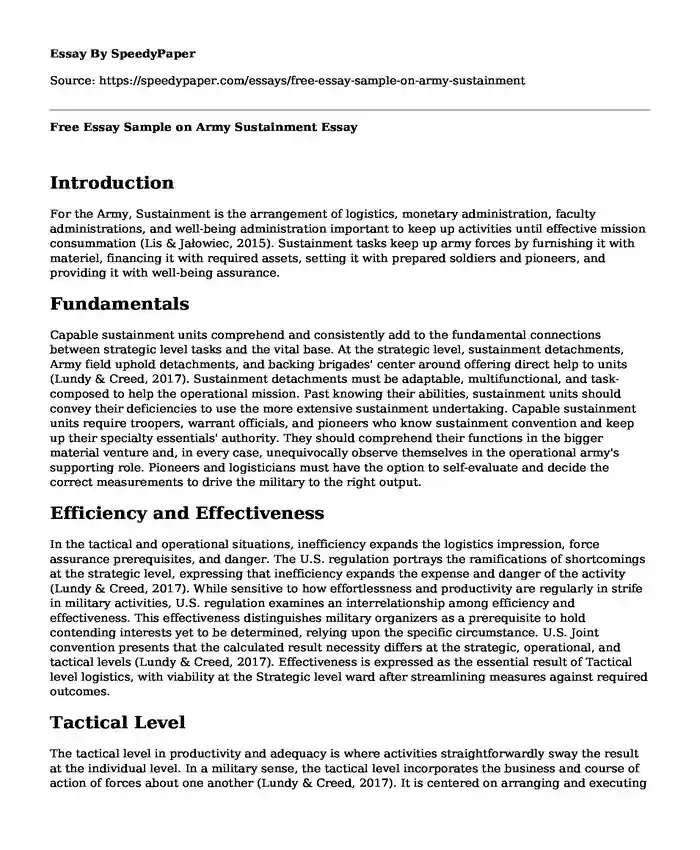
| Type of paper: | Essay |
| Categories: | United States Army |
| Pages: | 3 |
| Wordcount: | 769 words |
Introduction
For the Army, Sustainment is the arrangement of logistics, monetary administration, faculty administrations, and well-being administration important to keep up activities until effective mission consummation (Lis & Jalowiec, 2015). Sustainment tasks keep up army forces by furnishing it with materiel, financing it with required assets, setting it with prepared soldiers and pioneers, and providing it with well-being assurance.
Fundamentals
Capable sustainment units comprehend and consistently add to the fundamental connections between strategic level tasks and the vital base. At the strategic level, sustainment detachments, Army field uphold detachments, and backing brigades' center around offering direct help to units (Lundy & Creed, 2017). Sustainment detachments must be adaptable, multifunctional, and task-composed to help the operational mission. Past knowing their abilities, sustainment units should convey their deficiencies to use the more extensive sustainment undertaking. Capable sustainment units require troopers, warrant officials, and pioneers who know sustainment convention and keep up their specialty essentials' authority. They should comprehend their functions in the bigger material venture and, in every case, unequivocally observe themselves in the operational army's supporting role. Pioneers and logisticians must have the option to self-evaluate and decide the correct measurements to drive the military to the right output.
Efficiency and Effectiveness
In the tactical and operational situations, inefficiency expands the logistics impression, force assurance prerequisites, and danger. The U.S. regulation portrays the ramifications of shortcomings at the strategic level, expressing that inefficiency expands the expense and danger of the activity (Lundy & Creed, 2017). While sensitive to how effortlessness and productivity are regularly in strife in military activities, U.S. regulation examines an interrelationship among efficiency and effectiveness. This effectiveness distinguishes military organizers as a prerequisite to hold contending interests yet to be determined, relying upon the specific circumstance. U.S. Joint convention presents that the calculated result necessity differs at the strategic, operational, and tactical levels (Lundy & Creed, 2017). Effectiveness is expressed as the essential result of Tactical level logistics, with viability at the Strategic level ward after streamlining measures against required outcomes.
Tactical Level
The tactical level in productivity and adequacy is where activities straightforwardly sway the result at the individual level. In a military sense, the tactical level incorporates the business and course of action of forces about one another (Lundy & Creed, 2017). It is centered on arranging and executing fights, as opposed to great, or operational, methodology. The restricted local targets separate it, and frequently a brief span procedure utilized to accomplish many confined outcomes. The tactical level can incorporate units' activities and up to Task Force level, where those goals stay limited in their impact.
Operational Level
The operational level connects the tactical work of forces to public and military key targets. The emphasis is on the plan, arranging, and execution of tasks utilizing useful workmanship (Lundy & Creed, 2017). As an extension between the tactical, practical level of war, and the key level's psychological nature, the operational level can be separated into three features: the intellectual, useful, and valuable. From an intellectual perspective, it takes the theoretical, impalpable thoughts and translates them into solid plans (Lundy & Creed, 2017). Subsequently, the Operational level is more than the ligament that associates the strategic activity to wide technique – it is the idea, plans, and assets that change a key idea into composed physical activities.
Strategic Level
The Strategic level is where military reasoning and methodology meets with political will. The elements of common military relations, subsidizing allocation, and political contemplations essentially sway military plans and courses (Lundy & Creed, 2017). At this level, military organizers endeavor to set up viable plans and procedures while being driven by the superseding necessity for proficiency. The Strategic level is the level at which the military contributes as a component of public force. The consequence of proficiency at the strategic level affects both inward and outside of the association. Inside, organizers are regularly needed to adjust the contending necessities of staff, hardware, Sustainment, preparing, and upkeep to create ability outcomes (Lundy & Creed, 2017).
Conclusion
Tactics consistently require judgment and variation to a circumstance's special conditions. Strategies and systems are built up examples or cycles that can be applied more than once with little judgment to different conditions (Lundy et al., 2020). Together, strategies, methods, and methodology furnish authorities and staff with the basics to create strategic issues. The answer for a particular issue is an exceptional mix of these basics, current tactics, techniques, and procedures, and the making of new tactics, techniques, and procedures dependent on assessing the circumstance (Lundy et al., 2020). Administrators decide satisfactory arrangements by acing convention and current tactics, techniques, and procedures.
Cite this page
Free Essay Sample on Army Sustainment. (2023, Nov 26). Retrieved from https://speedypaper.com/essays/free-essay-sample-on-army-sustainment
Request Removal
If you are the original author of this essay and no longer wish to have it published on the SpeedyPaper website, please click below to request its removal:
- Metallica's Impact on Popular Culture, Music Essay Sample
- Essay Example on Human Rights in North Korea
- Essay Example on Effects of Falling Value of Euro
- How the Media Is Biased Towards Progressive-Liberal Values. Paper Example
- Resilience Is About How You Recharge Not How You Endure
- Free Essay: Nursing Workforce in Texas
- Analyzing Rhetorical Devices in George W. Bush Speech - Free Paper Sample
Popular categories




